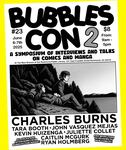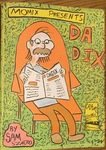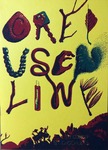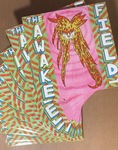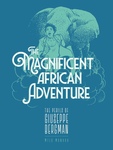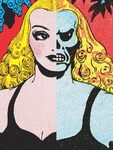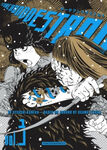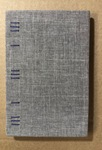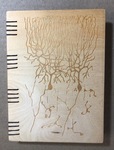
Quite a lot can – and will – be said about he comics that make up Milk White Steed, Michael Kennedy’s first book length collection published in North America. Composed of eight short to medium length stories along with a pair of interstitial two-pagers, it is filled with comics that are artistically grounded, visually stimulating, historically informed, and intellectually challenging, and that together make for a dis- / re-orienting reading experience that, while at times unsettling, is ultimately invigorating and highly rewarding.
A core component of the stories that make up Milk White Steed is their conveyance of the Black British experience. This is broadcast right at the outset, with a cover image that well sums up its unique and agglomerative nature, while also hinting at a chimerical aspect. The stories collected here largely work to articulate that experience, especially as it relates to those of West Indian heritage. It should be noted that while the realities of racial discrimination in Britain do overlap with those in America, there are considerable historical and cultural differences that many North American readers may be unfamiliar with (an introductory overview can be found here).
Kennedy’s strategies in representing the quality and character of Black British lives and times often employ and/or rely upon the figure of the duppy, a concept involving a spirit or ghost that originated in central Africa and later evolved to figure prominently in West Indian folklore, where it can be used to connect generations and also, in some respects, be seen as a device through which the past can be made manifest in the present, and more, besides. These employments can veer unexpectedly, yet nonetheless aptly, into the surreal – both visually in the artwork and also narratively, as automatic writing, free association and dream states, as well via incursions from the realms of science fiction and the supernatural into the quotidian.
The stories set in Britain (one is set in America) take place during the 3/4 century that has transpired since the end of the Second World War, which period coincides with the greatest in-migration to Britain from its former colonies. While historical and social realities obviously figure in these comics, it is within the realm of psychological experience that they most clearly excel. Here at Copacetic, over the course of reading Milk White Steed, there were numerous moments of déjà vu, that feeling of, “wait, have I read this before?” as Kennedy repeatedly connected this reader with archetypes undergirding their experience. How, exactly, he was able to effect this remains ensconced within the mystery of creativity, but certainly his evident immersion in and thoroughgoing study of the visual culture of the same 3/4 century in which these stories largely transpire is what enabled him to do so as successfully as he did.
The tributary sources of the visual schemas and art styles that variously emerge and submerge as one travels across the surface of the work in Milk White Steed reach back to the 1950s, connecting with the artistic streams that animated the comics exemplified by Harvey Kurtzman, as well as the surreally tinged science fiction artwork of the period, most fully embodied by Richard Powers, and the jazz illustration of the era, represented by the works of David Stone Martin, Jim Flora, and, of course, Jack Kirby, in whose body of work so much is subsumed, in order to best capture, render and evoke the historical forces shaping that period, and then moving on through imagery, styles and approaches derived from subsequent periods represented, which are threaded together tapestrically to present the simultaneity of being in their intermingling, as ancestors and progeny interact in the psyche of the present moment. Imprints of the comics of Gilbert & Jaime Hernandez, along with Dan Clowes are perhaps the most clearly visible (and Crumb), but glimmerings of a host of contemporaries including Dash Shaw, Jillian Tamaki, Yvan Alagbé along with the off-kilter perceptions embedded in the works of Ben Katchor and Eric Haven, and the novel graphic expressivities of the likes of Fort Thunder, Frank Santoro, Michael DeForge and E.S. Glenn, which also shine through. Whether or not, or to what degree, Kennedy's work directly connects to or derives from that of the aforementioned artists is of only secondary importance, or even entirely beside the point; the main thing is that he's "been there."
Yet this synthesis of his precursors is simply the base level upon which his comics edifice is erected. Kennedy brings a great deal of originality to his works. While Kennedy’s work is likely to be new to most readers, he has a decade’s worth of comics-making behind him and has been a professional illustrator for quite some time. His work on the 2018 graphic novel Tumult, shows him already having mastered the normative narrative comics form in its current state. Both prior to and following that work Kennedy produced a large body of personal/alternative comics work, much/most of which was collected in the self-published Mr. Hardee and five issues of MiNT, all of which are notoriously difficult to track down on this side of The Atlantic.
Kennedy understands better than most the communicative power of color, especially the three primary and secondary colors. He makes no secret of the importance of color to his works as they often figure in the story titles, as in “Green Men” “Yellowbird Blues”, “In the Blue Corner”, “Red Snapper in the Rea”, and, of course, the titular “Milk White Steed.”
All lettering throughout is by hand, with a special attention paid to the the title pages, each of which evokes a unique form of hand painted (shop) sign lettering that harkens back to the production technologies of yesteryear and serves, together with the rest, to build the world in which the characters and stories inhabit and evoke the environment in which they arose.
We've posted a hefty selection of pages from Milk White Steed on the Copacetic Tumblr to help; give you an idea of what we're talking about. Check it out.
Kennedy’s comics have broken new ground and his adaptation of the duppy to the world of comics is quite successful, revealing it to be ideally suited to the form. Milk White Steed is a signal work that has the potential to open a new chapter in the history of comics.
Here's a gift book for the dedicated and adventurous comics reader on your list.

